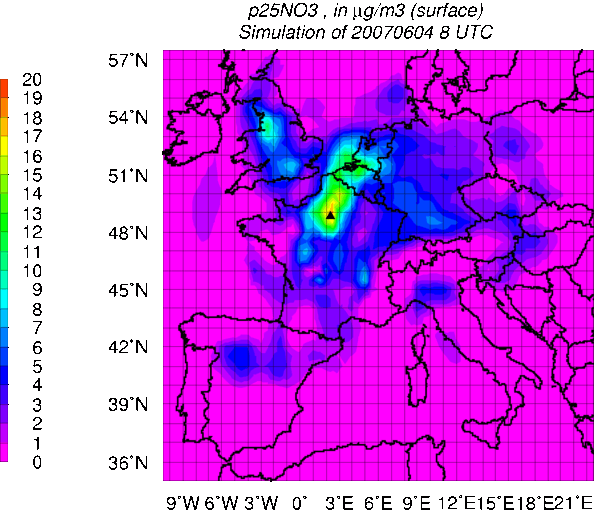Chemical transport and deposition models
Modeling with the 3D CHIMERE model
The chemical transport CHIMERE model, co-developed by IPSL and INERIS, takes into account emissions, the transport, chemical transformations, as well as the filing of the gaseous species and aerosols, to calculate their fields of concentrations on areas ranging from the urban scale to the continental scale. It uses the input data on emissions, on the use of soil and meteorological fields from simulations. The CHIMERE model has the status of national means, managed by the Dynamic Meteorology Laboratory (LMD). The source of the model codes are for free distribution (under GNU license) on the site http://www.lmd.polytechnique.fr/chimere/. Beyond its scientific use, the CHIMERE model is used to forecast the air quality in several AASQA, to the national scale in the PREVAIR (http://www.prevair.org) system to INERIS or the European scale (MACC project).
At LISA, the model is used for interpretation of intensive campaigns’ work (ESCOMPTE and MEGAPOLI projects), to simulate long distance transport of photochemical and particulate pollution (OLDAIR project), to simulate scenarios of emission reduction, finally for the assimilation of (MACC project for the last two) data and for modeling reverse emissions. These works also involve own developments, including the implementation of a chain of assimilation of observations in the model or for the refinement of the treatment of chemical transformations.
 |
Simulation of a continental plume of nitrate-phase particulate (PM2.5), ranging from the Benelux to the Paris region (triangle), June 4, 2007. For certain types of weather situations, the particle transport represents an important source of pollution for the Ile-de-France.
The cycle of desert aerosols in 3D modeling: CHIMERE-Dust and RAMS
A separate version of the CHIMERE (CHIMERE-Dust) model has been developed in collaboration with LMD [Menut et al., 2005, 2007; Schmechtig et al. submitted]. CHIMERE-Dust is a specific digital tool of the cycle of desert aerosols, fine resolution in time (hourly resolution) and space (resolution ~ tens of kilometers), but however allowing multi-year simulations (~ 10 years). The inclusion of the emission LISA model and the use of databases of state of adapted surfaces allow the "online" simulation of flux of emission and the size distribution of the produced aerosol. Taking into account the size distribution particularly as regards the representation of the deposition process has also been the subject of an original parameterization [forest et al., 2006]. CHIMERE-Dust thus addresses the terms of emissions, transport and deposition of these aerosols with appropriate temporal resolution, and to assess their impact at regional and continental scales. The most recent work focuses on a confrontation of simulations with satellite images and the experimental data obtained in the AMMA campaign in West Africa. In the CHARMEX project of the Mediterranean site, a work on the assessment of deposition fluxes of desert aerosols on the Mediterranean basin is initiated with CHIMERE-Dust.
The confrontation of simulations made with the CHIMERE-Dust model of satellite images on the Sahara-Sahel zone has highlighted some areas for which the model strongly underestimated desert aerosol emissions. It is for example the case of Bodele depression in northern Chad and the Sahel region. To understand and improve the representation of the cycle of desert aerosol in these areas, we use a meso-scale meteorological model, the Regional Atmospheric Modeling System (RAMS, Cotton et al. [2003]), coupled with the issuance of the LISA model online. The RAMS model is a meteorological model from of a meso-scale from the collaboration of the State University of Colorado (CSU, Colorado State University) and the division * Aster of the MRC (Mission Research Corporation) laboratory. This model is freely available to the scientific community (http://www.atmet.com), allowing at the same time the modeling and prevision (see for example http://rams.metlogic.com/index.shtml) of atmospheric phenomena, at a meso or less than a global scale. The coupling with the issuance of the LISA model was produced in collaboration with the laboratory of physics meteorology Clermont-Ferrand and for taking into account the radiative effect of desert aerosols, with the laboratory of atmospheric optics of Lille. The use of this model, of a scale less than the one from CHIMERE-Dust, must provide the CHIMERE-Dust model correction methods.
 |
Summary diagram of the RAMS-DPM-GAME model (source : © LISA)

